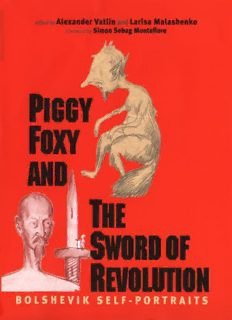
Piggy Foxy and the Sword of Revolution: Bolshevik Self-Portraits (Annals of Communism Series) PDF
Preview Piggy Foxy and the Sword of Revolution: Bolshevik Self-Portraits (Annals of Communism Series)
Piggy Foxy and the Sword of Revolution Piggy Foxy and the Sword of Revolution Bolshevik Self-Portraits Edited by Alexander Vatlin and Larisa Malashenko Translated by Vadim A. Staklo Foreword by Simon Sebag Montefiore Yale University Press New Haven & London ThisvolumehasbeenpreparedwiththecooperationoftheRussianStateArchiveofSocial andPoliticalHistory(RGASPI)oftheStateArchivalServiceofRussiaintheframeworkof anagreementconcludedbetweenRGASPIandYaleUniversityPress. Copyright©2006by LibraryofCongress Acataloguerecordforthisbookis YaleUniversity. Cataloging-in-PublicationData availablefromtheBritishLibrary. Allrightsreserved. Piggyfoxyandtheswordof Thisbookmaynotbereproduced, Thepaperinthisbook revolution:Bolshevikself- inwholeorinpart,including meetstheguidelinesforpermanence portraits/editedbyAlexander illustrations,inanyform(beyondthat anddurabilityoftheCommitteeon VatlinandLarisaMalashenko; copyingpermittedbySections107and ProductionGuidelinesforBook translatedbyVadimA.Staklo; 108oftheU.S.CopyrightLawand LongevityoftheCouncilonLibrary forewordbySimonSebag exceptbyreviewersforthepublic Resources. Montefiore. press),withoutwrittenpermission p.cm.—(AnnalsofCommunism) fromthepublishers. 10 9 8 7 6 5 4 3 2 1 Includesindex. isbn-13:978-0-300-10849-1 DesignedbyJamesJ.Johnsonand (alk.paper) setinSabonRomantypesby isbn-10:0-300-10849-4 TsengInformationSystems,Inc. (alk.paper) PrintedinItalybyEuroGraficaSpA. 1.SovietUnion—Politicsand government—1917–1936—Caricatures andcartoons.2.Vsesoiuznaia kommunisticheskaiapartiia (bol’shevikov)—Caricaturesand cartoons.3.Politicians—Soviet Union—Caricaturesandcartoons. I.Vatlin,A.IU.II.Malashenko, Larisa.III.Title:Bolshevik self-portraits.IV.Series. dk268.4.p542006 947.08402'07–dc22 2006009070 Contents Foreword by Simon Sebag Montefiore vii Acknowledgments xv Introduction 1 part one. Gallery of Leaders 11 V.I.Lenin 16 L.M.Kaganovich 44 I.V.Stalin 18 S.M.Kirov 46 L.B.Kamenev 20 A.I.Mikoyan 48 L.D.Trotsky 22 G.K.Ordzhonikidze 50 G.Ye.Zinoviev 24 V.V.Kuibyshev 52 N.I.Bukharin 26 V.Ya.Chubar 54 M.I.Kalinin 28 S.V.Kosior 56 V.M.Molotov 30 S.I.Syrtsov 58 A.I.Rykov 32 A.S.Bubnov 60 Ya.E.Rudzutak 34 G.M.Krzhizhanovsky 62 M.P.Tomsky 36 N.K.Krupskaia 64 F.E.Dzerzhinsky 38 M.M.Litvinov 66 A.A.Andreyev 40 G.L.Piatakov 68 K.Ye.Voroshilov 42 K.B.Radek 70 I.T.Smilga 72 R.P.Eideman 96 A.A.Solts 74 M.M.Lashevich 98 M.F.Shkiriatov 76 V.A.Antonov-Ovseyenko 100 Ye.M.Yaroslavsky 78 S.S.Kamenev 102 L.Ye.Mariasin 80 I.P.Tovstukha 104 S.L.Kruglikov 82 V.N.Vasilievsky 106 N.G.Tumanov 84 A.M.Nazaretian 108 N.P.Briukhanov 86 Ya.A.Yakovlev 110 G.I.Lomov(Oppokov) 88 D.Bedny 112 A.I.Gurevich 90 N.D.Kondratiev 114 N.Osinsky(V.V.Obolensky) 92 D.B.Riazanov 116 V.V.Shmidt 94 O.Yu.Shmidt 118 part two . Comrades and Problems 123 Deviations and Oppositions 123 Supplementary Agendas 141 Economic Conflicts and Rapid Industrialization 167 The Congress of theVictors and the Plenum of the Condemned 185 Index of Drawings by Artist 206 Foreword simon sebag montefiore T he history of the Bolsheviks during the brutal turbulence of their long revolution,fromtheseizureofpowerinOctober1917throughtheCivil Warandcollectivization,uptotheritualcannibalismoftheGreatTer- ror, is as absurd as it is grim. Its tragedy is made for satire yet defies caricature,foritsmadnessseemsbeyondhumor.Hencethegreatvalue of this remarkable collection of cartoons, caricatures, and drawings is that both the artists and the subjects were Bolshevik magnates. Not only most of the subjects but most of the artists toowere shot on Josef Stalin’s orders during theTerror. The caricatures are often outrageously, perversely funny. Indeed this book is highly comedic. But the laughter has an echo in the dungeons of Lubianka, and we can follow the foreboding and sadness and then the tragic bloodbath through these images.They are much more than just funny cartoons: they are golden assets for the historian,andIthink,inthefuture,historiansofStalinandStalinismwillhavetouse this book. They are of course part of the treasure chest formed by the Stalin and Politburo papersintheRussianStateArchiveofSocialandPoliticalHistory(RGASPI),formerly the Communist Partyarchive, in Moscow.The drawings and the archives themselves revealatotallydifferentpictureoftheSovietleadership:beforehand,wewerelimited to monolithic histories of grim institutions—Politburo, Orgburo, Sovnarkom—filled with mustachioed men without biographies. viii foreword TheRGASPI’swealthofarchivalmaterialrevealsthehumanityoftheleadersand, moreimportant,howtheentireregimeworkedonhumanterms:patronsandpatron- age, personal alliances and rivalries between characters and departments, fighting for power and, of course, for financial resources, were the essence of high politics in the Kremlin.WelearnthatStalinhimselfdidnotemerge,fullyformedafterLenin’sdeath, as a steely figure of fear and reserve. Far from it, he built power not on fear but on personal relationships not only with his henchmen, such as Molotov or Kaganovich, but also with more formidable intellectual figures such as Kamenev, Bukharin, and Radek.Thevery top of the Bolshevik pyramid was a tiny group of fanatical Marxist- Leninistsandtoughmanagers,hardenedbyalonglifeofundergroundconspiracyand tsaristprison,bloodiedinthesavagekillingoftheCivilWar,andlaterthewaronthe peasantry. Stalinwasthelinchpinofthesepersonalrelationships,thepatronofpatrons,and thearbiterofdepartmentalrivalries,butwemustbecarefulnottowritehistoryback- ward.Until1937,hewasregardedasthetoughestoftheBolshevikhardmen,buthewas stillanoldcomrade:thearchivesrevealhowintimatelyStalinlivedwiththeotherBol- shevikleaders.HeconstantlydroppedinonhisneighborsandfriendsintheirKremlin apartments, suburban dachas, and Black Sea holiday villas, as witnessed by his many notes to friends like Klim Voroshilov, Vyacheslav Molotov, and Demian Bedny sug- gesting dinners or trips to the countryas well as the discussion of political matters. These grandees, with their wives and children, their country houses and family parties,presidedoverastateofrepressionandpropaganda,arealmofmiseryandmass murder and prison camps.Yet the leaders could still tease and laugh at one another. The archives reveal the constant joshing and joking in Politburo meetings in which notes were constantly sent around the table and often Stalin himself took part. Only in1937 did this collegial political world disappear forever. Allthisisinthesedrawings,whichhelpsuslisteninonthetoneofthesetalented but brutal leaders with their towering egos and ambitions. The cartoonists, leaders themselves like Nikolai Bukharin and Valery Mezhlauk, mock the vanities of their comrades in witty and sophisticated jokes and often obscene language and images: amongsomuchpoliticaljargonandtoughbargaining,weseehilariousimagesofcas- trations and genital dismemberments. Here we can sense the idiosyncratic culture of high Bolshevism and its contra- dictions: the intellectual cultureversus the rudeworking-class machismo; the strange foreword ix system of repressive dictatorship mixed with the dying relics of partydemocracy; the mateycomradeshipoffriendlyequalsinapartywithoutaFührerprinzipalongsidethe growth of Stalin’s personal tyranny; the cheerful rough bonhomie of old comrades undermined by the cheerless, po-faced ambition of Stalin’s rising apparatchiks. The story is told in these invaluable historic documents: they are often enjoyed by Stalin himself, whowrites in his unmistakablyemphatic scrawl: ‘‘Correct’’ or ‘‘To allmembersofthePlenum,’’becausethedrawingsoftenservehisimmediatepolitical purposes. Manyare especially revealing.The drawings by Bukharin and Yaroslavsky ofStalinhimself(figs.4–6)revealhimasfriskilyvigilant,grimlydetermined,andun- attractivelylong-nosed:theycouldhavebeendrawnonlybySovietleadersbefore1937, anditisnosurprisetheyweredrawnbefore1930.Similarly,TrotskyappearsasStalin’s comradessawhim—apreeningSpanishtroubadour(fig.8).ThatwashowStalinsaw him too. The famous characters come across strongly: Yan Rudzutak’s notorious laziness (fig. 25), Feliks Dzerzhinsky’s almost religious fervor in his persecution of enemies (fig.28),Bukharin’saffablecharmthroughout,Voroshilov’smixtureofvanityandfun. TherearepricelessportraitsofSergoOrdzhonikidze’sdashingvigor,explosivelypas- sionate Georgian temper, and relentless pursuit of Stalin’s enemies (fig.103).There is Anastas Mikoyan’s dapper Caucasian glamour and Stalinist hardness. Both of these menwereruthlessStalinists,butOrdzhonikidzeisironicallyshownasatsaristofficer, MikoyanasaCaucasianmountainwarrior(fig.157).Interestingly,Ordzhonikidze,the lastbigbeastoftheBolshevikjungle,wouldbedriventosuicidebyStalinin1937,while theshrewd,felineMikoyanturnedouttobetheultimateSovietsurvivor—amanwho carriedLenin’scoffinin1924andattendedJohnF.Kennedy’sfuneralin1963,finishing his careeras chairman of the Presidium of the Supreme Soviet from1964 to1965. EventhefutureNKVDheadLavrentyBeriaappearsatthe1937plenum,stillboss ofCaucasia,usingthreatsanddenunciationstomakehisnameandprovehispotential tohispatron,Stalin.Aswellasfamouscomrades,suchastheblowhardleftistGrigory ZinovievandhisallyLevKamenev,thedreadedfacesoflessknownStalinisthatchet- men are fascinating too: the colorless Andrei Andreyev was one of theworst.The far fromcolorlessbutalmostunhingedLevMekhlis,editorofPravda,laterpoliticalboss oftheRedArmyandkillerofmanyofitsofficers,wassoexcessivelyStalinistthateven Stalin often mocked him for it. Mekhlis accumulated huge power as one of Stalin’s privatesecretaries,andtwoothersappearhere:IvanTovstukha,untilhisdeathin1935
Description: